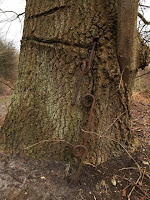I could not believe that Dunwich Common had been completely cleared of its WW2 remains so had another walk around today. Found some screw pickets and angle iron pickets that have been reused for game enclosures/tree planting in the past, and eventually stuck gold with a remaining 'destroyed' concrete structure with associated trenches/weapons-pits, similar to those at nearby Westleton. I had walked past these on at least three occasions so shows the value of revisiting sites and just to keep looking! Of note this time is that these works do coincide with a platoon locality (10th Cams, 15th Div). So is this location an existing platoon locality that was incorporated into the training works of Exercise Kruschen? As the destroyed concrete structure is identical to those at Westleton there is no doubt that this area was part of Kruschen. When I get round to completing the mapping of these works it will be interesting to see if the fields of fire from these 'igels' are all supporting each other.
I have now been going 'seriously' for one yr and the website has been going for 6 months (although only appearing on search engines for four months). I've corrected some obvious mistakes although others probably remain as I'm learning all the time! For this reason I've added a comments box on the Home Page of the website and would welcome any comments, positive or negative. Only hope it works, my IT skills are not that good!
Top: Screw Picket embedded in tree
Second Down: Screw Picket used in old game enclosure
Third Down: Trench, Dunwich Common
Bottom: Dugout with 'destroyed' concrete structure in background, Dunwich Common
I have now been going 'seriously' for one yr and the website has been going for 6 months (although only appearing on search engines for four months). I've corrected some obvious mistakes although others probably remain as I'm learning all the time! For this reason I've added a comments box on the Home Page of the website and would welcome any comments, positive or negative. Only hope it works, my IT skills are not that good!
Top: Screw Picket embedded in tree
Second Down: Screw Picket used in old game enclosure
Third Down: Trench, Dunwich Common
Bottom: Dugout with 'destroyed' concrete structure in background, Dunwich Common




Comments
Post a Comment